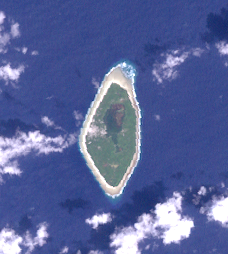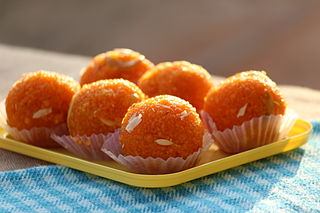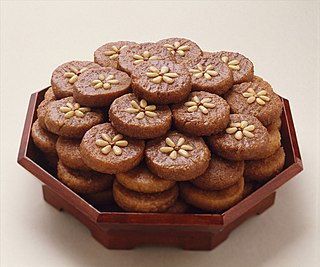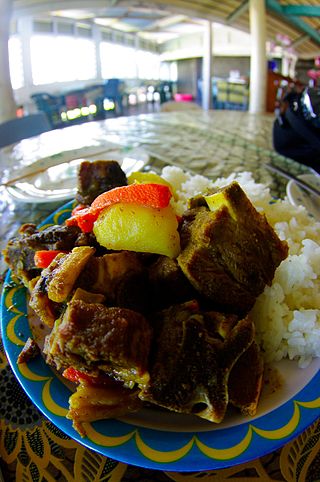
Tokelau is a dependent territory of New Zealand in the southern Pacific Ocean. It consists of three tropical coral atolls: Atafu, Nukunonu, and Fakaofo. They have a combined land area of 10 km2 (4 sq mi). The capital rotates yearly among the three atolls. In addition to these three, Swains Island, which forms part of the same archipelago, is the subject of an ongoing territorial dispute; it is currently administered by the United States as part of American Samoa. Tokelau lies north of the Samoan Islands, east of Tuvalu, south of the Phoenix Islands, southwest of the more distant Line Islands, and northwest of the Cook Islands.

The coconut tree is a member of the palm tree family (Arecaceae) and the only living species of the genus Cocos. The term "coconut" can refer to the whole coconut palm, the seed, or the fruit, which botanically is a drupe, not a nut. The name comes from the old Portuguese word coco, meaning "head" or "skull", after the three indentations on the coconut shell that resemble facial features. They are ubiquitous in coastal tropical regions and are a cultural icon of the tropics.

Copra is the dried, white flesh of the coconut from which coconut oil is extracted. Traditionally, the coconuts are sun-dried, especially for export, before the oil, also known as copra oil, is pressed out. The oil extracted from copra is rich in lauric acid, making it an important commodity in the preparation of lauryl alcohol, soaps, fatty acids, cosmetics, etc. and thus a lucrative product for many coconut-producing countries. The palatable oil cake, known as copra cake, obtained as a residue in the production of copra oil is used in animal feeds. The ground cake is known as coconut or copra meal.

Halva is a type of confectionery originating from Iran and widely spread throughout the Middle East and India. The name is used for a broad variety of recipes, generally a thick paste made from flour, butter, liquid oil, saffron, rosewater, milk, cocoa powder, and sweetened with sugar.

The traditional music of Tuvalu consists of dances, including fatele, fakanau and fakaseasea. The influence of the Samoan missionaries sent to Tuvalu by the London Missionary Society from the 1860s resulted in the suppression of songs about the traditional religions or magic and many songs were lost. As the influence of the missionaries diminished in the 20th century the traditional dances were revived and the siva dance tradition from Samoa also became popular. The fatele, in its modern form, is performed at community events and to celebrate leaders and other prominent individuals.

Nanumanga or Nanumaga is a reef island and a district of the Oceanian island nation of Tuvalu. It has a surface area of about 3 km2 with a population of 491.

Kuih are bite-sized snack or dessert foods commonly found in Southeast Asia and China. It is a fairly broad term which may include items that would be called cakes, cookies, dumplings, pudding, biscuits, or pastries in English and are usually made from rice or glutinous rice. In China, where the term originates from, kueh or koé (粿) in the Min Nan languages refers to snacks which are typically made from rice but can occasionally be made from other grains such as wheat. The term kuih is widely used in Malaysia, Brunei, and Singapore, kueh is used in Singapore and Indonesia, kue is used in Indonesia only, all three refer to sweet or savoury desserts.

Laddu or laddoo is a spherical sweet from the Indian subcontinent made of various ingredients and sugar syrup or jaggery. It has been described as "perhaps the most universal and ancient of Indian sweets."
Mithai (sweets) are the confectionery and desserts of the Indian subcontinent. Thousands of dedicated shops in India, Bangladesh, Nepal, Pakistan and Sri Lanka sell nothing but sweets.

Coconut candy refer to various candies made with coconut or coconut flavorings.

Severe Tropical Cyclone Keli was the first recorded post-season tropical cyclone to form in June within the South Pacific Ocean. The system formed on June 7, 1997, about 460 kilometers (285 mi) to the north of Tokelau. The depression gradually developed over the next few days while moving southwestward. It was designated as Tropical Cyclone Keli early the next day. Cyclone Keli intensified, slowly reaching its 10-minute peak wind speeds of 150 km/h, (90 mph), which made it a Category 3 severe tropical cyclone on the Australian Tropical Cyclone Intensity Scale. As it came under the influence of strong mid latitude westerlies and moved into an area of strong vertical wind shear, the cyclone started to weaken and was declared as extratropical on June 15.

ʻOta ʻika is a Oceanian dish consisting of raw fish marinated in citrus juice and coconut milk. The Tongan, Tahitian, and Samoan variants are essentially identical in that the raw fish is briefly marinated in lemon or lime juice until the surface of the flesh becomes opaque. The fish is then mixed with coconut milk and diced vegetables. This is the national dish of Tonga.

Yakgwa, also called gwajul (과줄), is a type of yumil-gwa, which is deep-fried, wheat-based hangwa made with honey, cheongju, sesame oil, and ginger juice. Traditionally, the sweet was offered in a jesa and enjoyed on festive days such as chuseok, marriages, or hwangap (sixtieth-birthday) celebrations. In modern South Korea, it is also served as a dessert and can be bought at traditional markets or supermarkets.
Pulaka, Cyrtosperma merkusii, or swamp taro, is a crop grown mainly in Tuvalu and an important source of carbohydrates for the area's inhabitants. It is a "swamp crop" similar to taro, but "with bigger leaves and larger, coarser roots." The same plant is known as ‘‘pulaka’’ in Niue, babai in Kiribati, puraka in Cook Islands, pula’a in Samoa, via, via kana or via kau in Fiji, pulaka in Tokelau, simiden in Chuuk, swam taro in Papua New Guinea, and navia in Vanuatu.

The cuisine of Tuvalu, a state in the Central Pacific (Oceania), is based on the staple of coconut and the many species of fish found in the ocean and the lagoons of the atolls of Tuvalu. Pulaka,, or swamp taro, is an important source of carbohydrates. Rice now forms an important part of the diet. Coconut is used in different forms with coconut water, coconut milk and the flesh of the coconut being used to flavour dishes. Various desserts made on the islands include coconut and coconut milk, instead of animal milk.

Severe Tropical Cyclone Ofa was a powerful tropical cyclone that caused severe damage in Polynesia in February of 1990. The system was first noted on January 27, 1990, near Tuvalu, as a shallow tropical depression that had developed within the South Pacific Convergence Zone. The cloud pattern slowly organized, and on January 31, while located east of Tuvalu, Ofa attained cyclone intensity. Moving slowly southeast, Ofa developed storm-force winds. It attained hurricane-force winds on February 2. Cyclone Ofa reached peak intensity on February 4. Shortly after, its peak Ofa began to weaken over a less favourable environment. Ofa was declared an extratropical cyclone on February 8, though the system was still tracked by meteorologists until February 10.

Severe Tropical Cyclone Tusi was a tropical cyclone which affected the island nations of Tuvalu, Tokelau, Western Samoa, American Samoa, Niue and the Southern Cook Islands during January 1987. The precursor tropical depression to Cyclone Tusi developed on January 13, within a trough of low pressure near the island nation of Tuvalu. Over the next few days the system gradually developed further before it was named Tusi during January 16, after it had become equivalent to a modern-day category 1 tropical cyclone on the Australian tropical cyclone intensity scale. After being named the system gradually intensified as it moved southeastwards along the trough, between the islands of Fakaofo and Swains during January 17. Tusi's eye subsequently passed near or over American Samoa's Manu'a Islands early the next day, as the system peaked in intensity with 10-minute sustained wind speeds of 150 km/h (90 mph). The system subsequently posed a threat to the Southern Cook Islands, however this threat gradually diminished as Tusi moved southwards and approached 25S during January 20.

Tuvaluan mythology tells stories of the creation of the islands of Tuvalu and of the founding ancestors of each island. While on some of the islands there are stories of spirits creating the islands, a creation story that is found on many of the islands is that te Pusi mo te Ali created the islands of Tuvalu; te Ali is believed to be the origin of the flat atolls of Tuvalu and te Pusi is the model for the coconut palms that are important in the lives of Tuvaluans. The strength of this belief has the consequence that Moray eel are tapu and are not eaten.
Te ano is a team sport played with 2 balls in which two teams face each other about 7 metres (23 ft) apart on a malae. Two balls are used simultaneously in the game with each ball being about 12 centimetres (4.7 in) in diameter, It is a traditional game played in Tuvalu, and also in the Pacific Islands of Tokelau & Sikaiana.
















